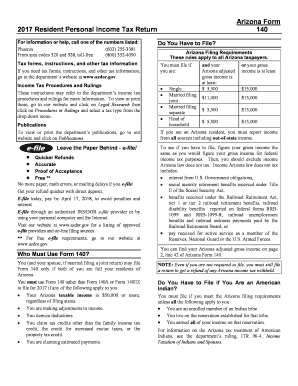Fill and Sign the 2017 Resident Personal Income Tax Return Form

Valuable advice on preparing your ‘2017 Resident Personal Income Tax Return’ online
Are you fed up with the inconvenience of handling paperwork? Look no further than airSlate SignNow, the premier eSignature solution for individuals and small to medium-sized businesses. Wave goodbye to the lengthy process of printing and scanning documents. With airSlate SignNow, you can effortlessly fill out and sign documents online. Utilize the powerful features embedded in this user-friendly and cost-effective platform and transform your method of document management. Whether you need to sign forms or collect electronic signatures, airSlate SignNow manages everything effortlessly, needing just a few clicks.
Follow this step-by-step instruction:
- Log into your account or register for a free trial of our service.
- Click +Create to upload a file from your device, cloud storage, or our form library.
- Open your ‘2017 Resident Personal Income Tax Return’ in the editor.
- Click Me (Fill Out Now) to finalize the document on your end.
- Add and assign fillable fields for other participants (if necessary).
- Proceed with the Send Invite settings to obtain eSignatures from others.
- Download, print your version, or convert it into a reusable template.
Don't worry if you need to collaborate with your coworkers on your 2017 Resident Personal Income Tax Return or send it for notarization—our platform offers everything you need to accomplish such tasks. Sign up with airSlate SignNow today and elevate your document management to a new standard!
FAQs
-
What is a Resident Personal Income Tax Return?
A Resident Personal Income Tax Return is a tax document that residents file to report their income and calculate their tax liability. It's essential for individuals to accurately complete their Resident Personal Income Tax Return to ensure compliance with tax laws and to maximize potential refunds.
-
How can airSlate SignNow help with my Resident Personal Income Tax Return?
airSlate SignNow provides an efficient platform for managing and eSigning your Resident Personal Income Tax Return documents. With its intuitive interface, users can easily prepare and send their tax returns securely, ensuring that all necessary signatures are obtained quickly.
-
Is airSlate SignNow affordable for filing a Resident Personal Income Tax Return?
Yes, airSlate SignNow is a cost-effective solution for businesses and individuals looking to streamline their document management, including the filing of a Resident Personal Income Tax Return. Our pricing plans are designed to cater to various needs, making it accessible for everyone.
-
What features does airSlate SignNow offer for tax document management?
airSlate SignNow offers features like document templates, automated workflows, and secure eSigning, which are all beneficial for managing your Resident Personal Income Tax Return. These features help save time and reduce errors, allowing you to focus on your financial planning.
-
Can I integrate airSlate SignNow with other tax software for my Resident Personal Income Tax Return?
Absolutely! airSlate SignNow can integrate seamlessly with various tax software and applications, enhancing your ability to manage your Resident Personal Income Tax Return. This integration allows for a smoother workflow, as you can easily transfer data and documents between platforms.
-
What security measures does airSlate SignNow have for my Resident Personal Income Tax Return?
Security is a top priority for airSlate SignNow. We employ advanced encryption and secure access protocols to ensure that your Resident Personal Income Tax Return and other sensitive documents are protected from unauthorized access.
-
Can I track the status of my Resident Personal Income Tax Return with airSlate SignNow?
Yes, airSlate SignNow provides tracking features that allow you to monitor the status of your Resident Personal Income Tax Return. You will receive notifications when documents are viewed, signed, or completed, ensuring you stay informed throughout the process.
Related searches to 2017 resident personal income tax return form
Find out other 2017 resident personal income tax return form
- Close deals faster
- Improve productivity
- Delight customers
- Increase revenue
- Save time & money
- Reduce payment cycles

